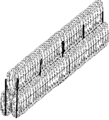Wire obstacle


In the
One example is "low wire entanglement", which consists of irregularly placed stakes that have been driven into the ground with only some 15 cm (six inches) showing. The barbed wire is then wrapped and tightened on to these. An enemy combatant running through the barrier, which is difficult to see, is apt to trip and get caught.
History
Wire obstacles were used by Union Army general Ambrose Burnside during the Battle of Fort Sanders in the Knoxville campaign of the American Civil War, when telegraph wire was strung between tree stumps 30 to 80 yards in front of one part of the Union line. The Royal Danish Army also used wire fences in front of its Danevirke fortifications during the Second Schleswig War. They first saw significant military use by British forces during the Second Boer War, and reached the pinnacle of visibility during World War I where they indirectly, together with machine guns, were responsible for many (although not the majority of) casualties in the trench warfare that dominated that conflict. Wire obstacles served to magnify the substantial advantage that the repeating rifle and rapid-firing artillery, along with machine guns, had given to the defending side in the new era of warfare.
World War I entanglements could in some places be tens of metres thick and several metres deep, with the entire space filled with a
Another method was to deliberately leave attractive-looking gaps in wire obstacles to give the appearance of a weak link in the defences. Such gaps were designed to act like a funnel, luring attacking troops through the opening and straight into the concentrated direct and enfilade fire of different machine gun emplacements. Because multiple
Enhanced effectiveness
The effectiveness of any wire obstacle is greatly increased by planting
Gallery
-
The "knife rest" or "Spanish rider" is a modern wire obstacle functionally similar to the cheval de frise, and sometimes called that.
-
Triple concertina wire fence.
-
A complex obstacle belt of low wire entanglement backed by a double apron fence. Both obstacles have movable openings that can be blocked with knife rests.
-
The deadly result ofenfilade fire during the Dieppe Raid of 1942: dead Canadian soldiers lie where they fell. Trapped between the beach and fortified sea wall (covered with barbed wire), they made easy targets for MG 34machineguns in a German bunker. The bunker firing slit is visible in the distance, just above the German soldier's head.
References
- ^ Popular Science. Bonnier Corporation. January 1919.




